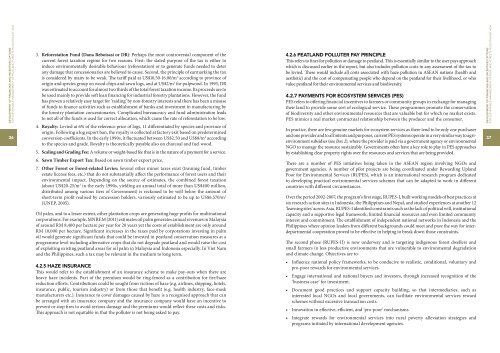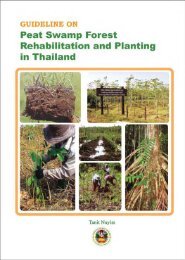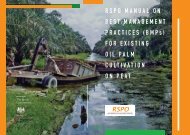Untitled - Peat Portal
Untitled - Peat Portal
Untitled - Peat Portal
Create successful ePaper yourself
Turn your PDF publications into a flip-book with our unique Google optimized e-Paper software.
DEVELOPMENT OF FINANCING AND INCENTIVES OPTIONSFOR SUSTAINABLE MANAGEMENT OF PEATLAND FORESTS IN SOUTHEAST ASIA363. Reforestation Fund (Dana Reboisasi or DR): Perhaps the most controversial component of thecurrent forest taxation regime for two reasons. First: the stated purpose of the tax is either toinduce environmentally desirable behaviour (reforestation) or to generate funds needed to deterany damage that concessionaries are believed to cause. Second, the principle of earmarking the taxis considered by many to be weak. The tariff paid at US$10.50-16.00/m 3 according to province oforigin and species group on wood chips and sawn logs, and at US$2/m 3 for pulpwood. In 1993, DRwas estimated to account for almost two thirds of the total forest taxation income. Its proceeds are tobe used mainly to provide soft loan financing for industrial forestry plantations. However, the fundhas proven a relatively easy target for ‘raiding’ by non-forestry interests and there has been a misuseof funds to finance activities such as establishment of banks and investment in manufacturing bythe forestry plantation concessionaries. Complicated bureaucracy and fund administration leadsto not all of the funds is used for correct allocation, which cause the rate of reforestation to be low.4. Royalty: Levied at 6% of the reference price of logs, 11 differentiated by species and province oforigin. Following a log export ban, the royalty is collected at factory exit based on predeterminedconversion coefficients. In the early 1990s, it fluctuated between US$2.50 and US$8/m 3 accordingto the species and grade. Royalty is theoretically payable also on charcoal and fuel wood.5. Scaling and Grading Fee: A volume or weight-based fee that is in the nature of a payment for a service.6. Sawn Timber Export Tax: Based on sawn timber export price.7. Other Forest or Forest-related Levies: Several other minor taxes exist (training fund, timberestate license fees, etc.) that do not substantially affect the performance of forest users and theirenvironmental impact. Depending on the source of estimates, the combined forest taxation(about US$20-25/m 3 in the early 1990s, yielding an annual total of more than US$400 million,distributed among various tiers of Government) is reckoned to be well below the amount ofshort-term profit realised by concession holders, variously estimated to be up to US$6,570/m 3(UNEP, 2005).Oil palm, and to a lesser extent, other plantation crops are generating huge profits for multinationalcorporations. For example, MNREM (2011) estimates oil palm generates annual revenues in Malaysiaof around RM 8,400 per hectare per year for 20 years yet the costs of establishment are only aroundRM 10,000 per hectare. Significant increases in the taxes paid by corporations investing in palmoil would generate significant funds that could be invested in peatland conservation measures at aprogramme level including alternative crops that do not degrade peatland and would raise the costof exploiting existing peatland areas for oil palm in Malaysia and Indonesia especially. In Viet Namand the Philippines, such a tax may be relevant in the medium to long term.4.2.6 PEATLAND POLLUTER PAY PRINCIPLEThis refers to fines for pollution or damage to peatland. This is essentially similar to the user pays approachwhich is discussed earlier in the report, but also includes pollution costs in any assessment of the tax tobe levied. These would include all costs associated with haze pollution in ASEAN nations (health andaesthetic) and the cost of compensating people who depend on the peatland for their livelihood, or whovalue peatland for their environmental services and biodiversity.4.2.7 PAYMENTS FOR ECOSYSTEM SERVICES (PES)PES refers to offering financial incentives to farmers or community groups in exchange for managingtheir land to provide some sort of ecological service. These programmes promote the conservationof biodiversity and other environmental resources that are valuable but for which no market exists.PES mimics a real market contractual relationship between the producer and the consumer.In practice, there are few genuine markets for ecosystem services as there tend to be only one purchaserand one provider and to all intents and purposes, current PES systems operate in a very similar way to agrienvironmentsubsidies (see Box 2), where the provider is paid via a government agency or environmentalNGO to manage the resource sustainably. Governments often have a key role to play in PES approachesby establishing clear property rights over the resources and services that are being provided.There are a number of PES initiatives being taken in the ASEAN region involving NGOs andgovernment agencies. A number of pilot projects are being coordinated under Rewarding UplandPoor for Environmental Services (RUPES), which is an international research program dedicatedto developing practical environmental services schemes that can be adapted to work in differentcountries with different circumstances.Over the period 2002-2007, the program’s first stage, RUPES-I, built working models of best practices atsix research action sites in Indonesia, the Philippines and Nepal, and studied experiences at another 12‘learning sites’ across Asia. RUPES-I identified constraints such as the lack of political will, institutionalcapacity and a supportive legal framework; limited financial resources and even limited communityinterest and commitment. The establishment of independent national networks in Indonesia and thePhilippines where opinion leaders from different backgrounds could meet and pave the way for interdepartmentalcooperation proved to be effective in helping to break down those constraints.The second phase (RUPES-II) is now underway and is targeting indigenous forest dwellers andsmall farmers in less productive environments that are vulnerable to environmental degradationand climate change. Objectives are to:• Influence national policy frameworks, to be conducive to realistic, conditional, voluntary andpro-poor rewards for environmental services.• Engage international and national buyers and investors, through increased recognition of the‘business case’ for investment.• Document good practices and support capacity building, so that intermediaries, such asinterested local NGOs and local governments, can facilitate environmental services rewardschemes without excessive transaction costs.• Innovation in effective, efficient, and ‘pro-poor’ mechanisms.• Integrate rewards for environmental services into rural poverty alleviation strategies andprograms initiated by international development agencies.DEVELOPMENT OF FINANCING AND INCENTIVES OPTIONSFOR SUSTAINABLE MANAGEMENT OF PEATLAND FORESTS IN SOUTHEAST ASIA374.2.5 hAZE INSURANCEThis would refer to the establishment of an insurance scheme to make pay-outs when there areheavy haze incidents. Part of the premium would be ring-fenced as a contribution for fire/hazereduction efforts. Contributions could be sought from victims of haze (e.g. airlines, shipping, hotels,insurance, public, tourism industry) or from those that benefit (e.g. health industry, face-maskmanufacturers etc.). Insurance to cover damages caused by haze is a recognised approach that canbe arranged with an insurance company and the insurance company would have an incentive toprevent or stop fires to avoid serious damage and the premiums would reflect these costs and risks.This approach is not equitable in that the polluter is not being asked to pay.





